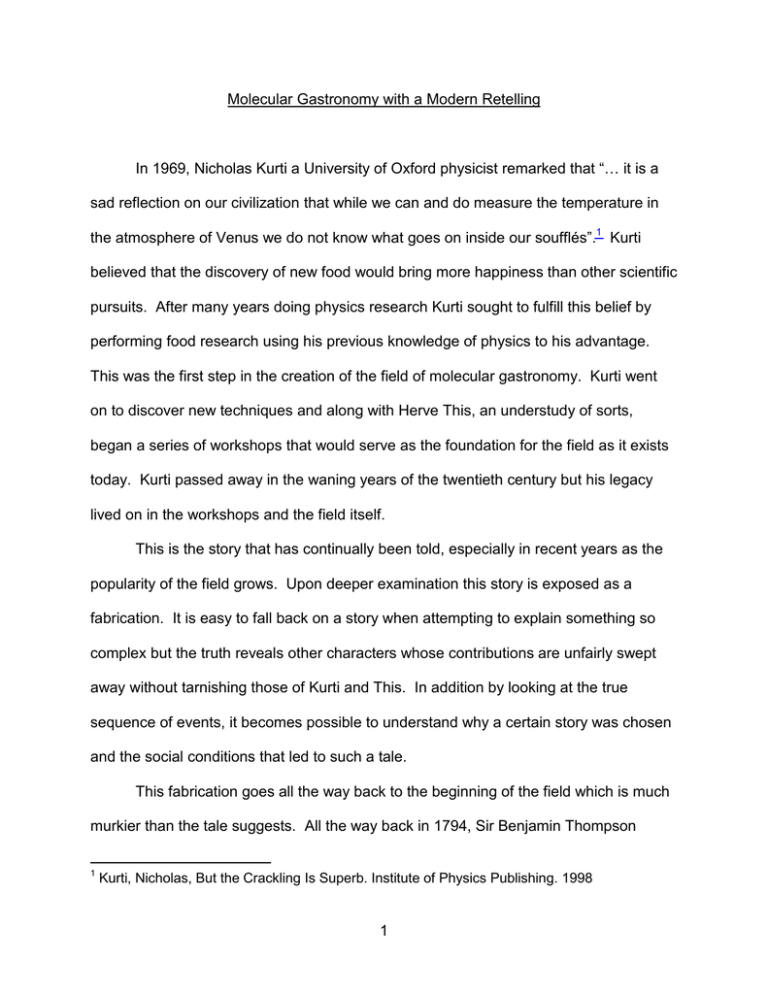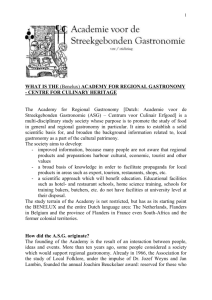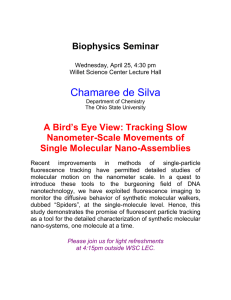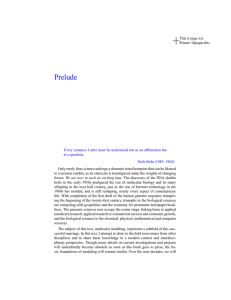Molecular Gastronomy with a Modern Retelling
advertisement

Molecular Gastronomy with a Modern Retelling In 1969, Nicholas Kurti a University of Oxford physicist remarked that “… it is a sad reflection on our civilization that while we can and do measure the temperature in the atmosphere of Venus we do not know what goes on inside our soufflés”.1 Kurti believed that the discovery of new food would bring more happiness than other scientific pursuits. After many years doing physics research Kurti sought to fulfill this belief by performing food research using his previous knowledge of physics to his advantage. This was the first step in the creation of the field of molecular gastronomy. Kurti went on to discover new techniques and along with Herve This, an understudy of sorts, began a series of workshops that would serve as the foundation for the field as it exists today. Kurti passed away in the waning years of the twentieth century but his legacy lived on in the workshops and the field itself. This is the story that has continually been told, especially in recent years as the popularity of the field grows. Upon deeper examination this story is exposed as a fabrication. It is easy to fall back on a story when attempting to explain something so complex but the truth reveals other characters whose contributions are unfairly swept away without tarnishing those of Kurti and This. In addition by looking at the true sequence of events, it becomes possible to understand why a certain story was chosen and the social conditions that led to such a tale. This fabrication goes all the way back to the beginning of the field which is much murkier than the tale suggests. All the way back in 1794, Sir Benjamin Thompson 1 Kurti, Nicholas, But the Crackling Is Superb. Institute of Physics Publishing. 1998 1 better known as Count Rumford published an essay in which he remarked that the application of chemistry and other branches of science to cookery was so apparent that he predicted scientific investigation in the almost immediate future.2 Count Rumford believed the advantages were so obvious that without hesitation some enlightened scientist would throw off his other work and begin to reap the advantages of such application. This was the basic idea for molecular gastronomy but it would become differentiated over the upcoming years. The idea of applying science to food can even be traced back to second century BC from an intact papyrus that weighed the differences in meat following different processes such as fermentation and cooking. In the early 19th century Marie-Antoine Carême, a famous French chef, investigated the proper method of making food stocks. In 1783 Antoine-Laurent de Lavoisier better known for his contributions to the filed of chemistry and death by guillotine in the French Revolution studied the different densities of food stocks in order to evaluate quality. These are only the pre-20th century contributors and they come no where close to being involved in the tale that has been woven about molecular gastronomy. It is certain that the foundations for the field were set many years before even the birth of Kurti. One of the other main discrepancies besides the dismissal of the early interworking of cuisine and science is the differentiation or lack thereof between gastronomy and food science. Food science is the general field for the application of science to food and the early focus of food science was in the molecular interaction in 2 Sir Benjamin Thompson, “On the construction of kitchen fireplaces and kitchen utensils, together with remarks and observations relating to the various processes of cookery, and proposals for improving that most useful art”. 1794. 2 food systems. In 1932 Professor Belle Lowe published a book titled Experimental Cookery: From the Chemical And Physical Standpoint which was a standard textbook for emerging field of home economics. This book contained many different experiments and referenced many of the earlier work in the field. With chapters focusing on the coagulation of proteins, factors affecting the viscosity of cream and other similar focuses, it is easy to see where the confusion can arise.3 With a table of contents that could be confused for a university science curriculum it becomes extremely difficult to differentiate this from the field of molecular gastronomy. Another group in this field are Evelyn Halliday and Isabel Noble who were both home economics professors who published a book Food Chemistry and Cookery that contained similar titles as Lowe’s work.4 Halliday and Noble’s work was even more scientific with looks into things such as hydrogen ion concentration and illustrations of lab experiments. For anyone looking at this field its very difficult to figure out why these are not considered to be part of the lineage of molecular gastronomy. In truth the modern meaning of gastronomy is certainly built on the works of the home economics professors of the early 20th century and even those of the 19th century as the techniques that were discovered would be utilized in the field in later years. While the work of earlier food science is a part of molecular gastronomy there is a clear delineation between the two fields. Some of the confusion that arises when tying food science and gastronomy directly together is because of the choice of name. The name molecular gastronomy was chosen because in the organizing of the first 3 Belle Lowe, Experimental Cookery: From the Chemical and Physical Standpoint(Nabu Press: 1932). 4 Evelyn G. Haliday and Isabel T. Noble, Food Chemistry and Cookery (University of Chicago Press: 1943). 3 workshop in 1992, the director of the venue where the gathering was to be held wanted a more fanciful title.5 So in order to meet the whimsy of the director the word molecular was added to the title of science and gastronomy. Today the misnomer has stuck and is not representative of the work that is going on. In the early 1990s the name referred to the way scientists examined what happened in food at a smaller level mostly in relation to past recipes and techniques. Later on the field developed and began to move more away from its strict scientific roots to a more unique artistic brand of cooking. Nowadays chefs that would technically be classified as molecular gastronomists are rejecting the term for the cold scientific nature of the name. There is a belief that was shared at the 2009 Madrid Fusion conference that the name doesn’t properly define their work at the intersection of science, art, psychology and cooking. Even though they agree that the term molecular gastronomy is not appropriate, even with the benefit of hindsight they are unable to agree on a clear definition and distinction between gastronomy and science. As a result of this lack of definition it can become difficult to understand just how the field started and from whom it began. The other main area of the creation of the field is focused on the workshops organized during the early 1990s. These workshops based in Erice, Sicily came to be known as the Erice workshops and have been attributed to Kurti and This. The story wrongly discredits Elizabeth Cawdry Thomas who was instrumental in the formation of the workshop. Thomas was married to a physicist and ran a cooking school in Berkeley, California. Thomas is one of the few Americans who was deeply involved in the movement. In a 1992 letter professor Ugo Valdre credited Thomas with coming up 5 Helston Blumenthal, Ferran Adria and Harold McGee,”Misnomer of a Name”. (Madrid Fusion 2009). Transcribed by Heather Sperling. 4 with the main idea for the workshop and was surprised at her lack of prevalence in the literature.6 Valdre remarked that the possibility for Thomas not being listed in the Organizing Committee was to avoid publicity for her Cooking School. Even Kurti in a letter to the another organizer credited Thomas with sparking off the project and being instrumental in the progress of the workshop.7 Yet within the same letter Kurti referred to Elizabeth Thomas as a “representative of the domestic chef”. Kurti did not give the same almost condescending representation of the other two co-organizers. In his description of the event to the director of the Center where the workshop was to be held, Kurti described Dr. Harold McGee and Dr. Herve This as both incredible cooks and scientists with glowing resumes of publications and accomplishments. Kurti already had strong relations with both as he had reviewed McGee’s work and had assisted This with his ongoing dissertation only a few months prior. He also routinely visited the two and had a much closer relation than Thomas who he had only been introduced to in the previous year with irregular correspondence by mail representing almost the whole of their relationship. It makes sense that Kurti would prefer to work with two people he considered friends and colleagues instead of someone he barely knew but by no means doe that make it fair. Kurti ended up excluding the founding member of the group that came up with the idea as well as one who was in the words of Ugo Valdre “instrumental to the starting, organization and successful achievement of the Erice Workshop on Molecular Gastronomy.” When the pamphlet came out advertising the event, Thomas’ name was almost impossible to find while Kurti, This and McGee enjoyed extreme prominence on the front cover. Valdre went on to elaborate in his letter to Thomas that 6 7 Ugo Valdre, letter to Elizabeth Cawdry Thomas. March 9, 1992. Nicholas Kurti, letter to Harold McGee. July 28, 1991. 5 he disagreed with her lack of inclusion and the reasons that Kurti cited. Even McGee has come out more recently to bring credit to Thomas and in his own words placing her contribution on par with Kurti. McGee left the organizing committee after the first workshop in 1992 leaving Kurti and This as the preeminent members of the workshop which they would remain until Kurti’s death six years later. This would continue to run the workshop with the name changed to the International Workshop on Molecular Gastronomy ‘ N. Kurti’”. In 1995 This published his doctoral dissertation titled Molecular and Physical Gastronomy in which he laid out the objectives of the field.8 Dr. This in effect established himself as the father of molecular gastronomy by calling himself its founder. Now that it is clear that Thomas was cut out of credit for the Erice workshop it is important to attempt to understand precisely why she was not credited appropriately. Like Belle Lowe, Evelyn Halliday and Isabel Noble Thomas had no formalized scientific training. She picked up her knowledge from relationships with her first husband who was a physicist and his colleagues with whom she had casual conversation. It became easy to pigeonhole Thomas in with the founders of the home economics movement. She was a woman with no formalized scientific knowledge who enjoyed cooking. Kurti even called her a representation of the domestic chef. She had come up with a brilliant idea to bring all these persons together but she was not viewed on the same level as people like Kurti or This who had formalized scientific training along with years of putting them to work in the kitchen. As a result it was possible that her skills were greatly discounted after being lumped in with a group that also struggles to get recognition. 8 This, Herve, "La gastronomie moléculaire et physique” (PhD diss., University of Paris VI) 1995. 6 The work of the home economics professor of the early 20th century also deserve at the very least some credit for the foundation they laid for later scientists. Even some of the experiments they did would not have looked out of place at the Erice workshops as they approached food topics from very scientific perspectives. Yet they too have been thrown aside for they did not show the creativity that later male counterparts did. This is a known problem in the world of food especially when it comes to chefs. All four of these women would be classified as chefs and are not alone in receiving less than adequate recognition. In San Pellegrino’s list of the world’s 50 Best Restaurants only two women appear, both one half of a male female team.9 Women are certainly under represented in the culinary world and have been for some time. Many have speculated on the causes with some focusing on the difficulties of motherhood coupled with a demanding job, others speculating about the fault within the kitchen atmosphere or in the media portrayal of high profile male chefs. Whatever the real reason may be, it cannot be ignored that there exists a stigma towards women when it comes to the kitchen. It is certainly a possibility that similarities in background between Thomas and earlier home economics professors allowed the former to be discounted despite the fact that her contributions were appreciated by many. This discrimination if true would fall on the shoulders of the organizers This and Kurti. Gender discrimination may not have been the only reason that Thomas and others were marginalized. Another name that hasn’t come up yet but was influential in the formation of the field is Ferran Adrià. Adrià is considered one of the best chefs in the world and practices techniques that would fall in the realm of molecular gastronomy. 9 San Pellegrino & Aqua Panna. “The World’s 50 Best Restaurants Guide 2014” (2014). 7 In 1988 he began experimenting with scientific cuisine and opened his own laboratoryworkshop in 1997 to further this study. He was one of the great chefs at the time who was using methods being discussed at the Erice workshop. He would have been a perfect example of this new cuisine and is considered by McGee to be the most influential pioneer of experimental cooking. But he was never invited to Erice. Despite all of the talk for the innovation and birth of molecular gastronomy at Erice, only two chefs emerged as serious renowned chefs. Heston Blumenthal and Pierre Gagnaire, English and French respectively, were the only two to have attended the workshops and translate that to restaurant success. Even then Blumenthal only started attending in 2001 and Gagnaire in the words of McGee was entreatingly ambivalent about the technical innovation.10 So the workshops were not instrumental in the development of any of the famed gastronomists. Blumenthal actually amazed the assembled crowd when he attended when he demonstrated what was occurring in the outside world. Even these two had something in common with the other members of the workshop and that was there nationality. The composition of the workshop participants was decidedly French and English focused. Adrià was Spanish and no chef working in Spain was ever invited. Even Kurti who was of Hungarian birth was noticeably French and English in his demeanor. He spoke both French and English and even attended the Sorbonne in Paris during his earlier years. He was a member of the Royal Society and gave his crackling is superb talk in front of the decidedly English audience. Herve This was a complete Frenchmen with his education coming in France along with working for the countries’ government on multiple occasions. There has always been a significance 10 Harold McGee, “The Curious Cook: More Kitchen Science and Lore”. (Wiley, April 1992) 8 that comes with French cuisine. With its long and rich history French cuisine has been seen as the pinnacle of culinary expertise since the end of the French Revolution. As a result it is not uncommon to associate those of French origin as more able chefs. This theory does not just apply to the Spanish as someone like Elizabeth Thomas could have been discriminated against for her American nationality. It is not uncommon for old world prejudice to exist. Even many of the naming of new techniques are named in French such as sous vide which means cooking under vacuum. It is impossible to examine molecular gastronomy without analyzing the stigmas that have been associated with certain nationalities. After looking at the history of gastronomy from the perspective of the story that has been told, as well as what actually happened and the discriminations against certain parties it becomes necessary to look at why the story was chosen. Why are This and Kurti considered the two fathers of molecular gastronomy when there are so many other contributors? With the benefit of hindsight it becomes very clear why the story of This and Kurti was chosen. Both chefs are male with decidedly French influences and fit well into the outsiders perspective of molecular gastronomy. They are scientists first who turned to food after either old age or curiosity led them to apply science to food. They were close friends despite Kurti being over forty years older than This. Kurti was able to act as a mentor of sorts for This who had the ability to start his investigations at a much younger age and not be one of the few involved in the field. In addition, despite being a bit cynical, the death of Kurti allowed him to immortalized as a founder of the field. This took advantage of Kurti’s death by attaching the name of his departed colleague to the workshop of which he was the primary organizer. In no way 9 is it implied that this was purposefully done by This. The effect is that This was able to permanently attach himself to Kurti’s legacy one which was only enhanced by his tragic passing. As the field gained more and more steam the Erice workshop provided a strong starting point that allowed people to classify a definite start and end. This narrative while convenient has been shown incorrect but a it has been proven that in many cases that the clean narrative is preferred over the truth when it comes to understanding history. This narrative became so widespread that This himself even focused on this narrative in a 2005 paper. He acknowledges some of the previous work such as Lavoisier and Count Rumford but does not acknowledge any of the home economics professors or Elizabeth Thomas.11 This instead creates a delineated by saying that Kurti and This incorrectly defined the field when they first started and that molecular gastronomy was the science of culinary process and that what had come before was the science of ingredients. This fact may be true but This easily casts aside the work of those who came before and does not acknowledge people like Thomas who were instrumental in the foundation of this new field anyway. Overall the narrative makes sense. It is easy to understand for a layman and conforms to some of the prejudices that may have been present at the time. This has not been an attempt to undermine or sell short the work of Kurti and This. They were obviously very involved in the process and deserve a share of the credit. The argument is that there are others who have been not given the credit they deserve and who should be considered alongside the two supposed founders. This is especially true when looking at the reasons why some of these people may have been 11 Herve This, “Food for tomorrow? How the scientific discipline of molecular gastronomy could change the way we eat”. EMBO REP (7(11)) November 2007. doi:10.1038/sj.embor.7400850 10 omitted for reasons such as gender or nationality. Narratives are powerful. They are succinct, easily digestible and in the best of cases true. But when the narrative strays from the true story and complex interactions are boiled out, it does a disservice to those whose work should not be forgotten. People like Elizabeth Thomas made molecular gastronomy and the gathering of people possible. People like Belle Lowe laid the groundwork on which food science was built and she in turn worked off the discoveries of people like Lavoisier. This process was by no means linear. Still the true story, while a little messier, gives credit where it is due and allows a proper understanding of the social conditions that accompanied this field. At the very least we are closer to understanding what happens in a soufflé. 11 MIT OpenCourseWare http://ocw.mit.edu 21H.S01 Food in American History Fall 2014 For information about citing these materials or our Terms of Use, visit: http://ocw.mit.edu/terms.





